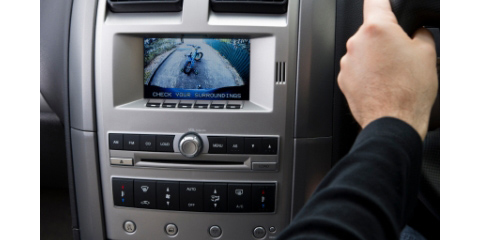
Technological advance in cars over the past ten years has seen a great many new safety and automation features that can help all drivers, but are especially useful to drivers who may have more restricted eyesight, reactions or mobility. They are primarily controlled by radar and/or cameras mounted in various places such as bumpers, the grille, behind vehicle badging, and in the windscreen.
Reversing Cameras
Reversing cameras give you better visibility of what's immediately behind your car, particularly small items like toddlers in the driveway. Camera images are shown on in-dash screens which are now up to 12-inches diagonally, but usually 5-8 inches.
Lane Departure Warning and Lane Keep Systems
Using cameras to monitor where the white lines are on the road, the car will warn you audibly or by vibrating the steering wheel if you drift out of your lane without indicating. Lane Keep systems will gently steer your car back between the lines itself.
Radar Cruise Control
Regular cruise control keeps your car at a fairly steady speed. Radar cruise control scans the road ahead for vehicles and will brake to adjust your speed to the vehicle in front, keeping a preset distance behind it. When that vehicle moves out of the way, it will resume your previous speed.
Automated Parking
Around-view systems gather images from cameras mounted in strategic areas of the vehicle to offer a full picture of the its edges. Pieced together, and shown on a dashboard monitor, they effectively provide a birds-eye view of the car that moves as the car moves. In certain models, drivers can select an individual camera view to enable more precise movements.
Blind Spot Warning Systems
Using the same sensors as for parking, the car scans to the side and backwards into the blind spots. If it detects a vehicle it will usually display an orange light in the wing mirror. If you indicate to move into that lane the orange light flickers and there may also be an audible warning.
Automated Braking and Collision Prevention
Pedestrians always come off second best when they connect with a vehicle. In an attempt to lessen the injury caused to pedestrians involved in collisions, car designers have worked with safety regulators to rethink hoods and bumpers.
In some cars, car-mounted sensors are able to detect if a pedestrian has been struck, and pop the hood up to modify the angle of impact and prevent severe head damage.
Using forward-facing cameras and the parking sensors the vehicle detects objects in your way, such as a pedestrian stepping out in front of you. It will perform an emergency stop if it thinks a crash is imminent.
Night Vision
Driving at night has always been more hazardous – it is harder to spot pedestrians and other debris on the road ahead, when you can only rely on the beam of your headlights and your passenger's eyesight.
Now, thanks to advances in thermal imaging and infrared radiation, your car may be able to spot trouble in the way before you even detect it. Images are captured with sophisticated cameras and displayed on dashboard-mounted screens or head-up displays, lighting up the road in a way that headlamps cannot.
Smart Sensors
It can be hard to stay alert on a long journey, even with a car full of passengers, loud music and plenty of coffee. Driving tired is almost as dangerous as drink driving. Several car manufacturers have developed systems that detect erratic driver behavior and notify the driver.
Some distracted-driver monitors use cameras and facial recognition software to detect unusual behavior behind the wheel. Others utilise software that compares driving styles and motions against previous, smooth operation, and displays a coffee mug icon accordingly.
Lane-departure warning systems alert drivers who are veering off and out of their lane. The systems use laser sensors and cameras to warn drivers, often accompanied by a vibration in the seat or steering wheel. In some systems, the warning turns from passive safety into active safety, and moves the vehicle back into place.
The Future of Cars
Many of the above features are available in some cars costing less than $70,000, e.g. Ford Kuga or Honda Accord. However, cars will eventually become driverless, perhaps within 10-15 years. To find out what that might be like, read this article – it will be a complete game-changer for our roads.
This video explains Bosch's predictive emergency braking system
This video explains Lane Keep Assist on a Toyota Prius









Join the Discussion
Type out your comment here:
You must be logged in to post a comment.